Titania Photonic Crystals with Precise Photonic Band Gap Position via Anodizing with Voltage versus Optical Path Length Modulation
Abstract
:1. Introduction
2. Materials and Methods
2.1. Anodizing Conditions
2.2. Experiments at Constant Voltage
2.3. Fabrication of Photonic Crystals
- The OPL of one structure period, L0, was chosen with respect to the desired position of PBG at normal incidence of light on sample surface (λ0 = 2L0). Thus, the OPL of the whole ATO film is Ltotal = N·L0, where N is the number of structure periods.
- The OPL of the layers obtained at 40 and 60 V was chosen equal to 0.5L0 unless otherwise indicated.
- Total duration of synthesis, t0, was set before anodizing as a parameter. The value of t0 is the time between beginning of anodizing and the rinsing of the sample.
- At the initial stage (L = 0 nm, t = 0 h), the anodizing voltage was set to 40 V.
- After a short time-interval Δt (ca. 30 ms), the charge density increment was calculated, where j(t) is current density in the electrical circuit.
- The increment of the OPL of ATO at wavelength λ0 is computed as a function of the charge density increment (Δq), anodizing voltage (U), and the time of etching in the electrolyte (te = t0 – t): ΔL = OPL(Δq, U, te) = Δd(Δq, U)·neff(U, te).
- A new value of the OPL is calculated as: L(t) = L(t – Δt) + ΔL. Then, the voltage was set to the new value U(L(t)) which corresponds to the value of OPL in accordance with the required voltage—OPL profile.
- Steps 5–7 were repeated until L(t) became higher than Ltotal. After that, the power supply was switched off and the sample was exposed to the electrolyte under open circuit conditions until t > t0.
2.4. Samples Characterization
3. Results and Discussion
4. Conclusions
Supplementary Materials
Author Contributions
Funding
Acknowledgments
Conflicts of Interest
References
- Yablonovitch, E.; Gmitter, T.J.; Leung, K.M. Photonic band structure: The face-centered-cubic case employing nonspherical atoms. Phys. Rev. Lett. 1991, 67, 2295–2298. [Google Scholar] [CrossRef] [PubMed]
- Joannopoulos, J.D.; Johnson, S.G.; Winn, J.N.; Meade, R.D. Photonic Crystals: Molding the Flow of Light, 2nd ed.; Princeton University Press: Woodstock, Oxfordshire, UK, 2008; ISBN 978-0-691-12456-8. [Google Scholar]
- Furchi, M.; Urich, A.; Pospischil, A.; Lilley, G.; Unterrainer, K.; Detz, H.; Klang, P.; Andrews, A.M.; Schrenk, W.; Strasser, G.; et al. Microcavity-integrated graphene photodetector. Nano Lett. 2012, 12, 2773–2777. [Google Scholar] [CrossRef]
- Fenzl, C.; Hirsch, T.; Wolfbeis, O.S. Photonic crystals for chemical sensing and biosensing. Angew. Chem. Int. Ed. 2014, 53, 3318–3335. [Google Scholar] [CrossRef] [PubMed]
- Guldin, S.; Hüttner, S.; Kolle, M.; Welland, M.E.; Müller-Buschbaum, P.; Friend, R.H.; Steiner, U.; Tétreault, N. Dye-sensitized solar cell based on a three-dimensional photonic crystal. Nano Lett. 2010, 10, 2303–2309. [Google Scholar] [CrossRef] [PubMed]
- Goban, A.; Hung, C.-L.; Hood, J.D.; Yu, S.-P.; Muniz, J.A.; Painter, O.; Kimble, H.J. Superradiance for atoms trapped along a photonic crystal waveguide. Phys. Rev. Lett. 2015, 115, 063601. [Google Scholar] [CrossRef]
- DeVore, J.R. Refractive indices of rutile and sphalerite. JOSA 1951, 41, 416–419. [Google Scholar] [CrossRef]
- Luo, W.; Ma, H.; Mou, F.; Zhu, M.; Yan, J.; Guan, J. Steric-Repulsion-Based Magnetically Responsive Photonic Crystals. Adv. Mater. 2014, 26, 1058–1064. [Google Scholar] [CrossRef]
- Zhao, Q.; Finlayson, C.E.; Snoswell, D.R.E.; Haines, A.; Schäfer, C.; Spahn, P.; Hellmann, G.P.; Petukhov, A.V.; Herrmann, L.; Burdet, P.; et al. Large-scale ordering of nanoparticles using viscoelastic shear processing. Nat. Commun. 2016, 7, 11661. [Google Scholar] [CrossRef] [PubMed]
- Li, J.; Liang, B.; Liu, Y.; Zhang, P.; Zhou, J.; Klimonsky, S.O.; Slesarev, A.S.; Tretyakov, Y.D.; O’Faolain, L.; Krauss, T.F. Photonic crystal formed by the imaginary part of the refractive index. Adv. Mater. 2010, 22, 2676–2679. [Google Scholar] [CrossRef]
- Wang, G.; Wang, J.; An, Y.; Wang, C. Anodization fabrication of 3D TiO2 photonic crystals and their application for chemical sensors. Superlattices Microstruct. 2016, 100, 290–295. [Google Scholar] [CrossRef]
- Lin, J.; Liu, X.; Zhu, S.; Chen, X. TiO2 nanotube structures for the enhancement of photon utilization in sensitized solar cells. Nanotechnol. Rev. 2015, 4, 209–238. [Google Scholar] [CrossRef]
- Wang, K.; Liu, G.; Hoivik, N.; Johannessen, E.; Jakobsen, H. Electrochemical engineering of hollow nanoarchitectures: Pulse/step anodization (Si, Al, Ti) and their applications. Chem. Soc. Rev. 2014, 43, 1476–1500. [Google Scholar] [CrossRef]
- Sapoletova, N.A.; Kushnir, S.E.; Napolskii, K.S. Anodic titanium oxide photonic crystals prepared by novel cyclic anodizing with voltage versus charge modulation. Electrochem. Commun. 2018, 91, 5–9. [Google Scholar] [CrossRef]
- Kim, W.-T.; Choi, W.-Y. Fabrication of TiO2 photonic crystal by anodic oxidation and their optical sensing properties. Sens. Actuators Phys. 2017, 260, 178–184. [Google Scholar] [CrossRef]
- Zheng, L.; Cheng, H.; Liang, F.; Shu, S.; Tsang, C.K.; Li, H.; Lee, S.-T.; Li, Y.Y. Porous TiO2 photonic band gap materials by anodization. J. Phys. Chem. C 2012, 116, 5509–5515. [Google Scholar] [CrossRef]
- Lin, J.; Liu, K.; Chen, X. Synthesis of periodically structured titania nanotube films and their potential for photonic applications. Small 2011, 7, 1784–1789. [Google Scholar] [CrossRef]
- Yip, C.T.; Huang, H.; Zhou, L.; Xie, K.; Wang, Y.; Feng, T.; Li, J.; Tam, W.Y. Direct and seamless coupling of TiO2 nanotube photonic crystal to dye-sensitized solar cell: A single-step approach. Adv. Mater. 2011, 23, 5624–5628. [Google Scholar] [CrossRef]
- Choy, T.C. Effective Medium Theory: Principles and Applications, 2nd ed.; Oxford University Press: Great Clarendon Street, Oxford, UK, 2016; ISBN 978-0-19-870509-3. [Google Scholar]
- Albu, S.P.; Kim, D.; Schmuki, P. Growth of aligned TiO2 bamboo-type nanotubes and highly ordered nanolace. Angew. Chem. Int. Ed. 2008, 47, 1916–1919. [Google Scholar] [CrossRef]
- Liu, Y.; Chang, Y.; Ling, Z.; Hu, X.; Li, Y. Structural coloring of aluminum. Electrochem. Commun. 2011, 13, 1336–1339. [Google Scholar] [CrossRef]
- Rahman, M.M.; Garcia-Caurel, E.; Santos, A.; Marsal, L.F.; Pallarès, J.; Ferré-Borrull, J. Effect of the anodization voltage on the pore-widening rate of nanoporous anodic alumina. Nanoscale Res. Lett. 2012, 7, 474. [Google Scholar] [CrossRef]
- Kushnir, S.E.; Napolskii, K.S. Thickness-dependent iridescence of one-dimensional photonic crystals based on anodic alumina. Mater. Des. 2018, 144, 140–150. [Google Scholar] [CrossRef]
- Ghicov, A.; Schmuki, P. Self-ordering electrochemistry: A review on growth and functionality of TiO2 nanotubes and other self-aligned MOx structures. Chem. Commun. 2009, 0, 2791–2808. [Google Scholar] [CrossRef]
- Kojima, R.; Kimura, Y.; Bitoh, M.; Abe, M.; Niwano, M. Investigation of influence of electrolyte composition on formation of anodic titanium oxide nanotube films. J. Electrochem. Soc. 2012, 159, D629–D636. [Google Scholar] [CrossRef]
- Liu, Y.; Wang, D.; Cao, L.; Chen, S. Structural engineering of highly ordered TiO2 nanotube array by periodic anodization of titanium. Electrochem. Commun. 2012, 23, 68–71. [Google Scholar] [CrossRef]
- Galstyan, V.; Vomiero, A.; Comini, E.; Faglia, G.; Sberveglieri, G. TiO2 nanotubular and nanoporous arrays by electrochemical anodization on different substrates. RSC Adv. 2011, 1, 1038–1044. [Google Scholar] [CrossRef]
- Varghese, O.K.; Gong, D.; Paulose, M.; Grimes, C.A.; Dickey, E.C. Crystallization and high-temperature structural stability of titanium oxide nanotube arrays. J. Mater. Res. 2003, 18, 156–165. [Google Scholar] [CrossRef]
- Lee, C.-Y.; Schmuki, P. Engineering of Self-Organizing Electrochemistry: Porous Alumina and Titania Nanotubes. In Advances in Electrochemical Science and Engineering; Alkire, R.C., Bartlett, P.N., Lipkowski, J., Eds.; John Wiley & Sons, Ltd: Hoboken, NJ, USA, 2015; pp. 145–192. ISBN 978-3-527-69063-3. [Google Scholar]
- Young, L. Anodic Oxide Films; Academic Press: New York, NY, USA, 1961. [Google Scholar]
- Kushnir, S.E.; Pchelyakova, T.Yu.; Napolskii, K.S. Anodizing with voltage versus optical path length modulation: A new tool for the preparation of photonic structures. J. Mater. Chem. C 2018, 6, 12192–12199. [Google Scholar] [CrossRef]
- Lin, Y.; Lin, Q.; Liu, X.; Gao, Y.; He, J.; Wang, W.; Fan, Z. A highly controllable electrochemical anodization process to fabricate porous anodic aluminum oxide membranes. Nanoscale Res. Lett. 2015, 10, 495. [Google Scholar] [CrossRef]
- Singh, J. Optical Properties of Condensed Matter and Applications; John Wiley & Sons: The Atrium, Southern Gate, Chichester, West Sussex, UK, 2006; ISBN 978-0-470-02193-4. [Google Scholar]
- Macak, J.M.; Tsuchiya, H.; Ghicov, A.; Yasuda, K.; Hahn, R.; Bauer, S.; Schmuki, P. TiO2 nanotubes: Self-organized electrochemical formation, properties and applications. Curr. Opin. Solid State Mater. Sci. 2007, 11, 3–18. [Google Scholar] [CrossRef]
- Sadykov, A.I.; Kushnir, S.E.; Roslyakov, I.V.; Baranchikov, A.E.; Napolskii, K.S. Selenic acid anodizing of aluminium for preparation of 1D photonic crystals. Electrochem. Commun. 2019, 100, 104–107. [Google Scholar] [CrossRef]
- Roslyakov, I.V.; Gordeeva, E.O.; Napolskii, K.S. Role of electrode reaction kinetics in self-ordering of porous anodic alumina. Electrochim. Acta 2017, 241, 362–369. [Google Scholar] [CrossRef]
- Macak, J.M.; Hildebrand, H.; Marten-Jahns, U.; Schmuki, P. Mechanistic aspects and growth of large diameter self-organized TiO2 nanotubes. J. Electroanal. Chem. 2008, 621, 254–266. [Google Scholar] [CrossRef]
- Chen, B.; Lu, K. Hierarchically branched titania nanotubes with tailored diameters and branch numbers. Langmuir 2012, 28, 2937–2943. [Google Scholar] [CrossRef] [PubMed]
- Lim, S.L.; Liu, Y.; Li, J.; Kang, E.-T.; Ong, C.K. Transparent titania nanotubes of micrometer length prepared by anodization of titanium thin film deposited on ITO. Appl. Surf. Sci. 2011, 257, 6612–6617. [Google Scholar] [CrossRef]
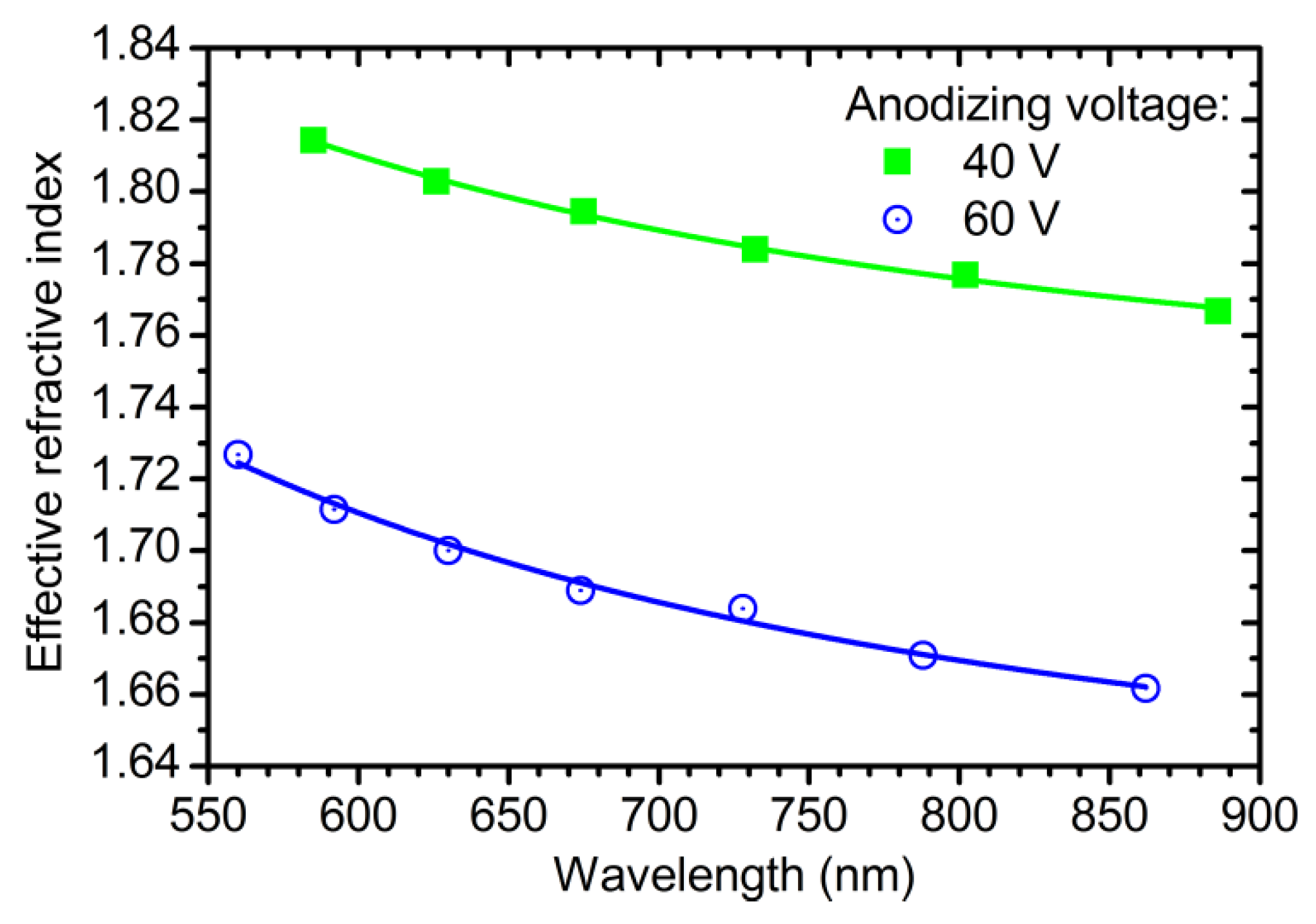
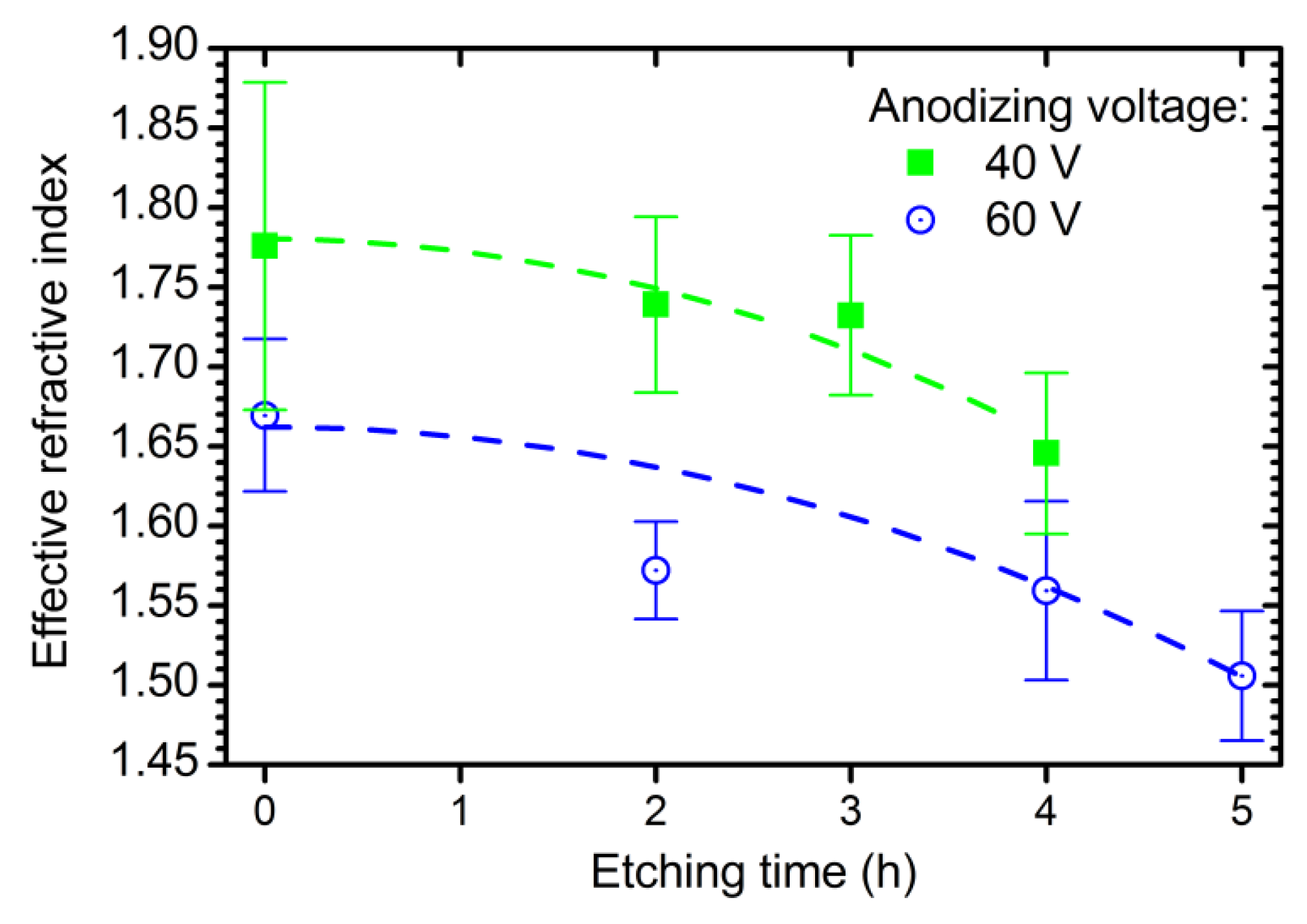
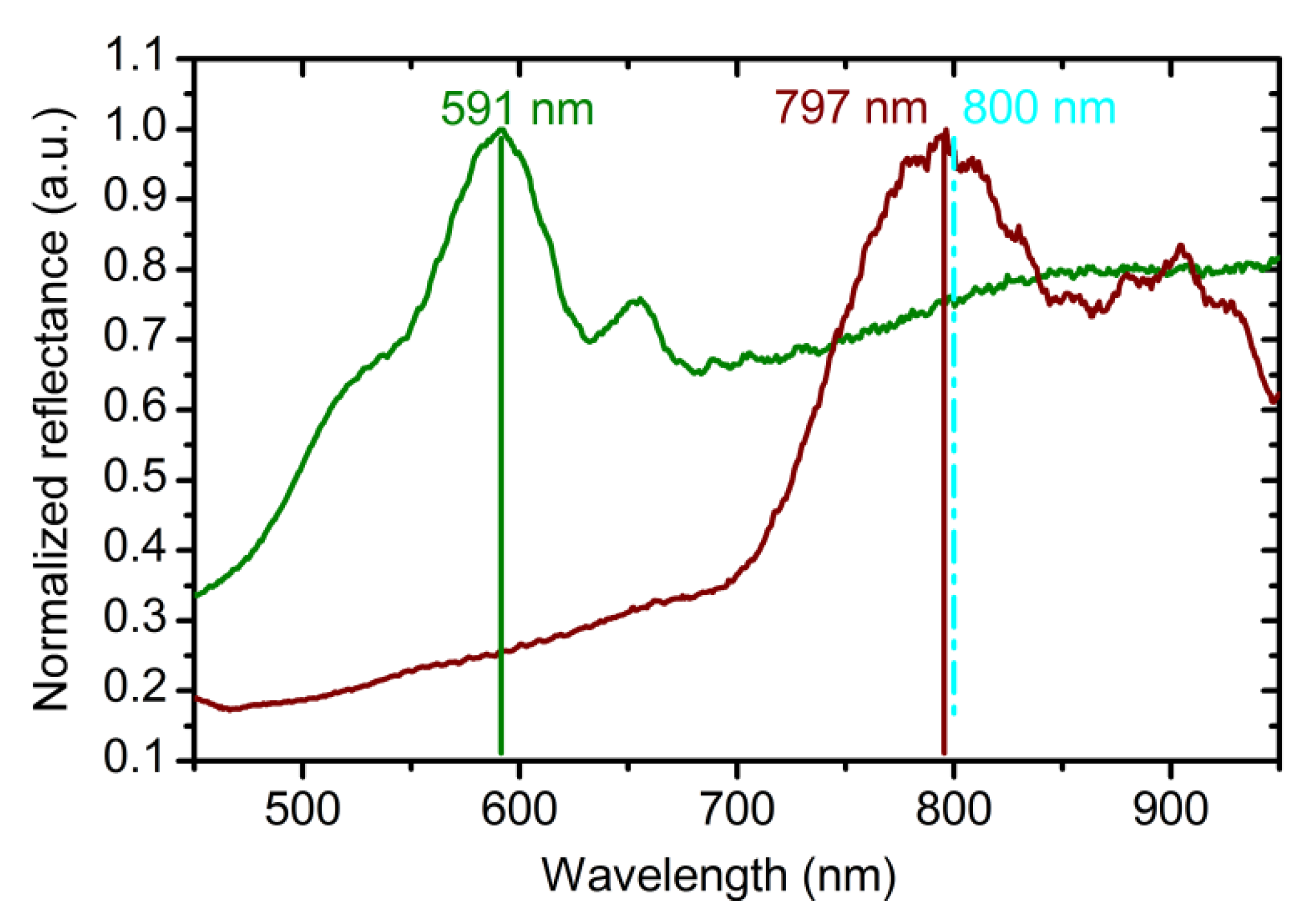

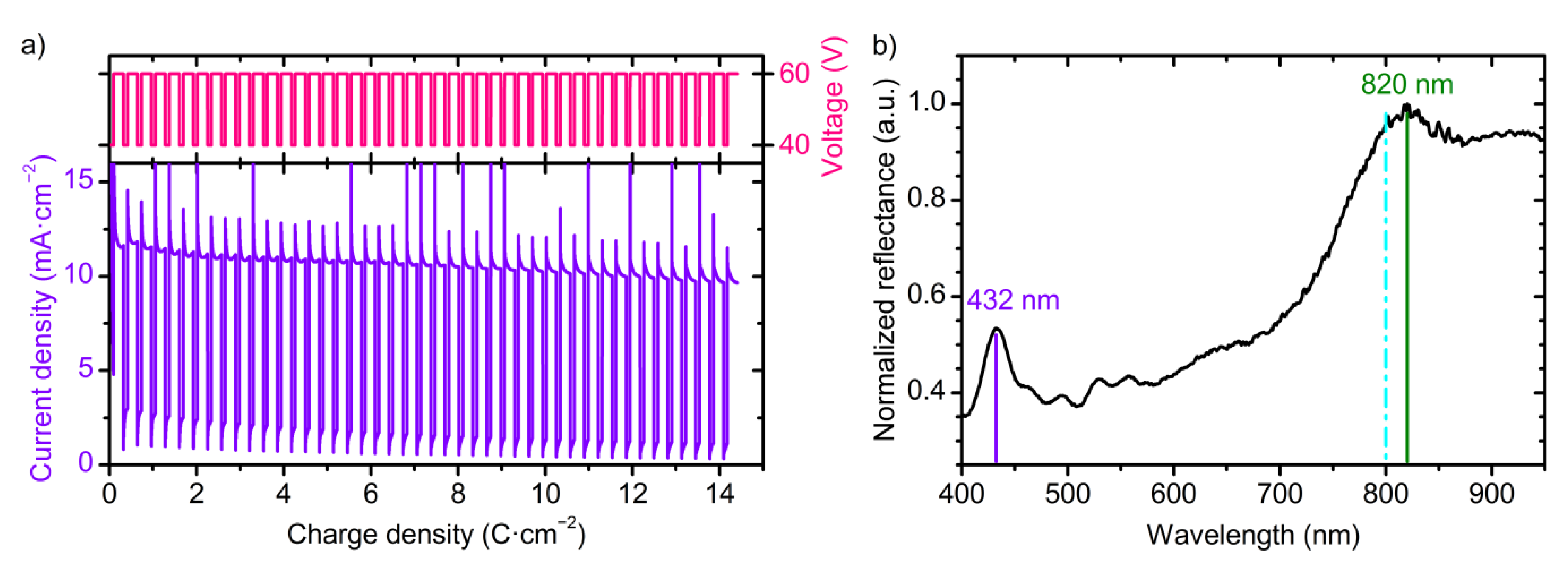
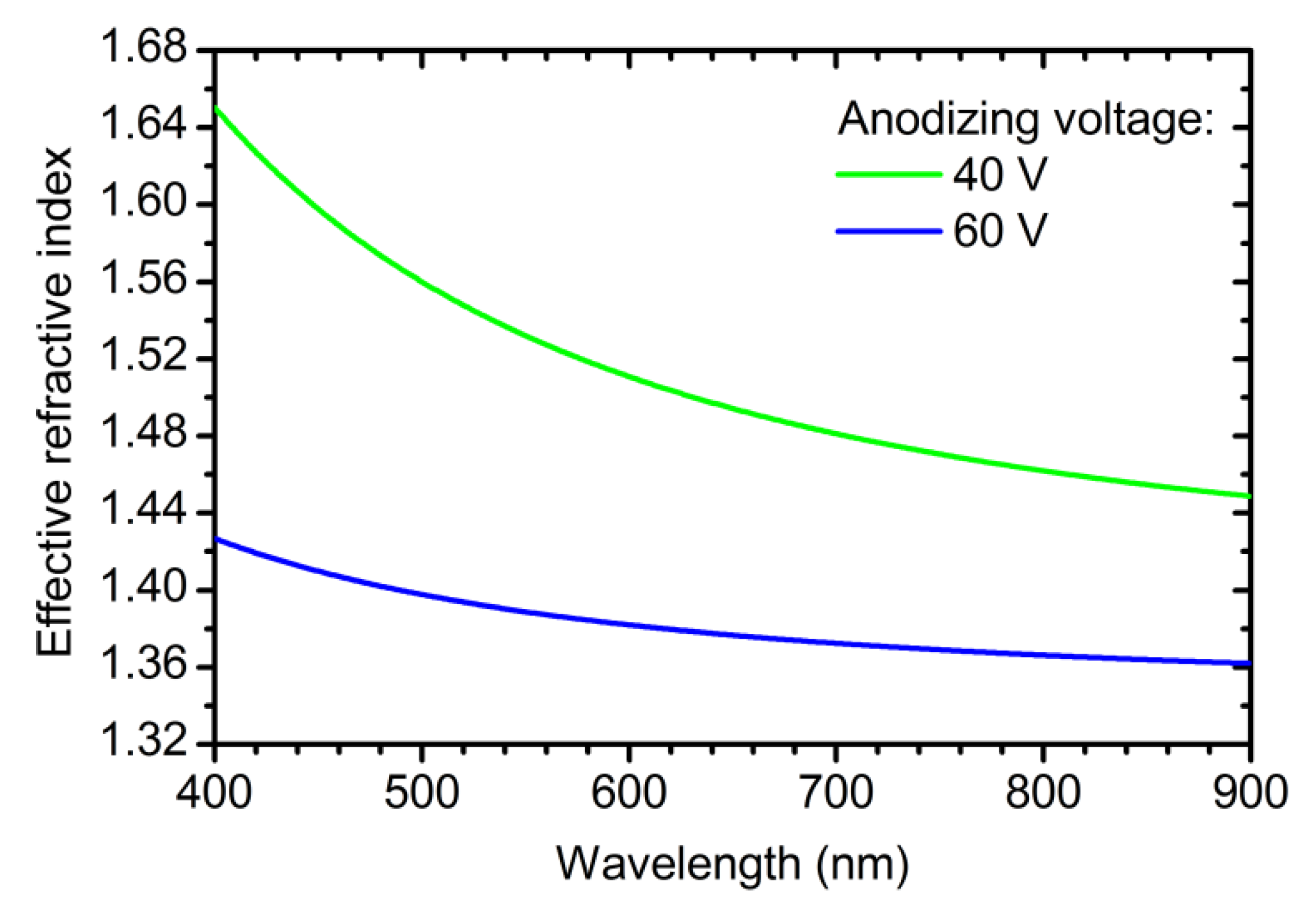

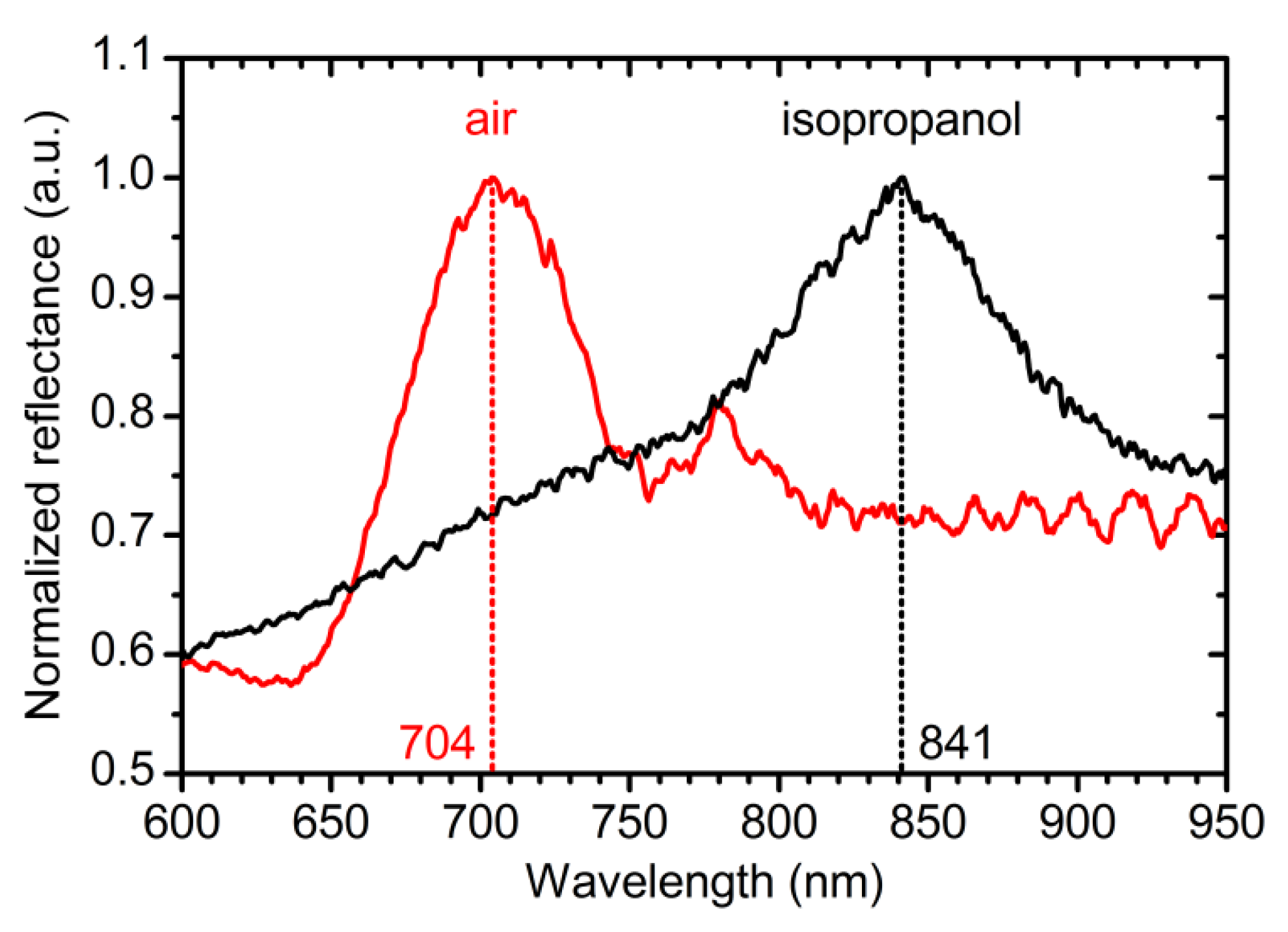
© 2019 by the authors. Licensee MDPI, Basel, Switzerland. This article is an open access article distributed under the terms and conditions of the Creative Commons Attribution (CC BY) license (http://creativecommons.org/licenses/by/4.0/).
Share and Cite
Ermolaev, G.A.; Kushnir, S.E.; Sapoletova, N.A.; Napolskii, K.S. Titania Photonic Crystals with Precise Photonic Band Gap Position via Anodizing with Voltage versus Optical Path Length Modulation. Nanomaterials 2019, 9, 651. https://doi.org/10.3390/nano9040651
Ermolaev GA, Kushnir SE, Sapoletova NA, Napolskii KS. Titania Photonic Crystals with Precise Photonic Band Gap Position via Anodizing with Voltage versus Optical Path Length Modulation. Nanomaterials. 2019; 9(4):651. https://doi.org/10.3390/nano9040651
Chicago/Turabian StyleErmolaev, Georgy A., Sergey E. Kushnir, Nina A. Sapoletova, and Kirill S. Napolskii. 2019. "Titania Photonic Crystals with Precise Photonic Band Gap Position via Anodizing with Voltage versus Optical Path Length Modulation" Nanomaterials 9, no. 4: 651. https://doi.org/10.3390/nano9040651
APA StyleErmolaev, G. A., Kushnir, S. E., Sapoletova, N. A., & Napolskii, K. S. (2019). Titania Photonic Crystals with Precise Photonic Band Gap Position via Anodizing with Voltage versus Optical Path Length Modulation. Nanomaterials, 9(4), 651. https://doi.org/10.3390/nano9040651





